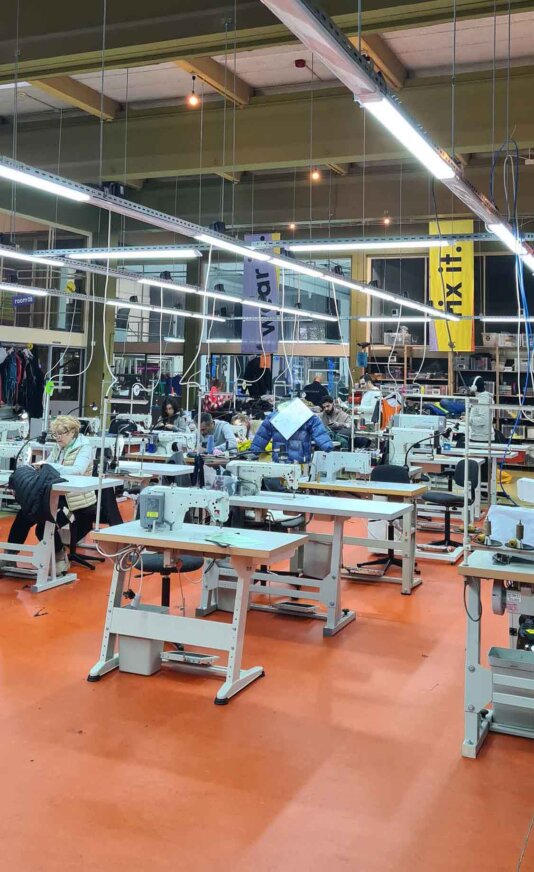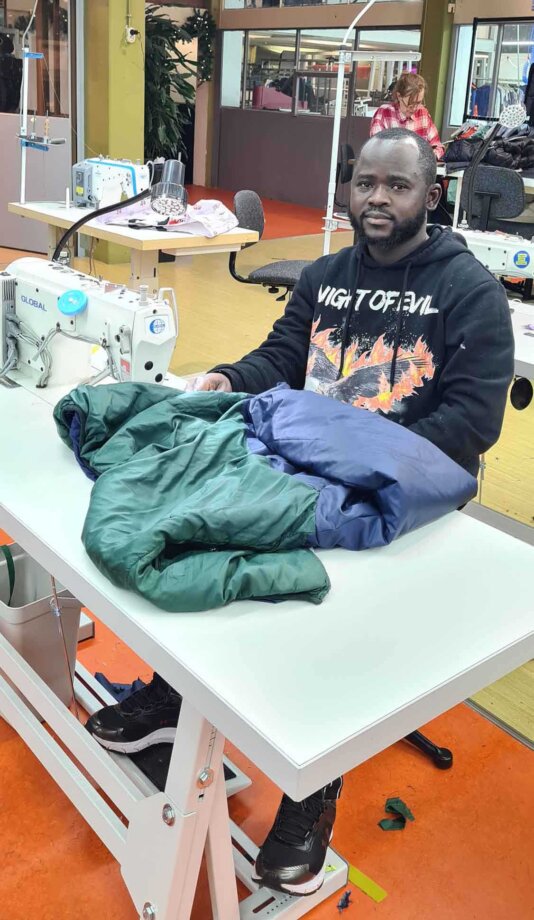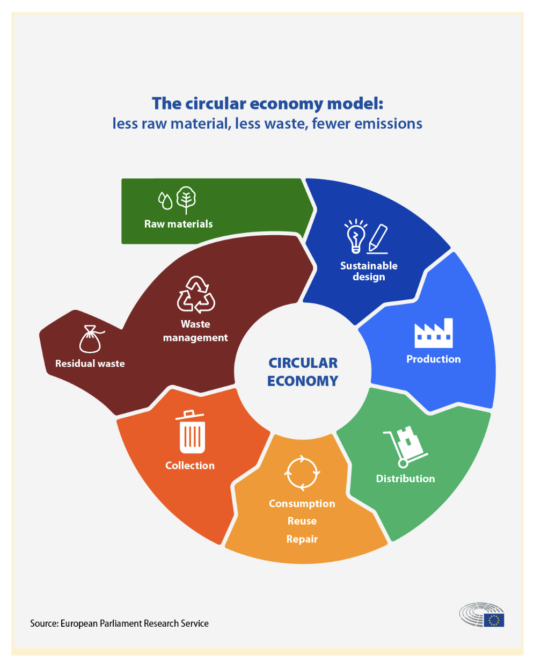- About
- Topics
- Picks
- Audio
- Story
- In-Depth
- Opinion
- News
- Donate
- Signup for our newsletterOur Editors' Best Picks.Send
Read, Debate: Engage.
| December 28, 2023 | |
|---|---|
| topic: | Refugees and Asylum |
| tags: | #fashion industry, #circular economy, #refugees, #migrants, #Netherlands |
| located: | Netherlands |
| by: | Jess McCulloch |
Stepping through the door of a large but warm warehouse, out from a cold winter day in Amsterdam, I’m greeted by some friendly faces and the gentle clacking of busy sewing machines. The textiles workshop is lit up by bright LED lights and Christmas decorations on the walls.
Branded banners remind me to ‘Wear it. Fix it. Repeat.’
Rails of jackets and clothes of all colours and sizes surround a central workstation where tailors sew, mend and upcycle the clothing repairs assigned to them to match their skills and expertise.
This is the United Repair Centre, a for-profit social enterprise extending the lifespan of clothes by employing repair tailors who fled their countries, refugees and economic migrants who they prefer to more warmly call newcomers and people at a distance of the labour market.
Privately funded by a consortium of impact investors, the centre opened last September. Its mission? Offering high quality repair services to brands to reduce garments ending up in landfills. The company stands for social inclusion, providing equal opportunities to newcomers and locals by making products with a story that matters.
One tailor, Richard, 34, is new to the team. Now in his seventh week, I ask him why repair is important.
"With so many new products all the time, people want to buy new and forget old fashion," he said. "But we shouldn’t. We’re showing them how to make their old clothes better."
Richard has been living in the Netherlands since 2017 and was a tailor for years in Nigeria, where he was making new clothes. Now, he is using these skills to work on repairs and upcycling.
Richard said that so far he loves this work and will "pour hope into the job."
"All hope is not lost," he added.
Back at his desk, he shows me the garment he is working on, a green jacket that he has upcycled with blue panels because the texture of the older material was too worn.
The centre employs 17 full-time tailors plus around ten part-time workers. The production manager, Ton, tells me it is a multicultural team of tailoring experts from countries including Palestine, Ukraine, Syria, Iran and Morocco.
Although they do not have a common language, the team members speak the same universal language of tailoring.
I sat down with Maria Clara Jimenez Assmus, the Colombian Director of Makers Unite, which is United Repair Centre’s sister foundation.
Assmus, who is not a refugee herself, says it is mostly outdoor and sportswear that are worn down the most. The repair centre works business-to-business, fixing clothes for brands like Patagonia, LuluLemon, Rapha, Kathmandu and Decathlon.
"Patagonia has worked with repairs since it was founded and we became the European hub for the repairs of Patagonia in 2021," Assmus said.
"The team upcycles around 430 garments a week and works on the fixing and reimagining of about 50 items a week for the Worn Wear project in the Berlin shop."
She added, "The idea for the repair centre evolved from our first ever foundation Maker’s Unite in 2016, where our six-week Creative Lab programme was one of the winners of What Design Can Do’s ‘Refugee Challenge’ in 2017, giving us the €10k seed funding to get the work off the ground."
They began by focusing on bringing people together as a community. "Our initial community project was to find a way to repurpose life jackets that so many migrants rely on during their difficult journeys to seek asylum. One project was to upcycling these into laptop cases and more," Assmus shared.
"Since then, we have hosted 21 six week Creative Labs over seven years for 293 people. We also will launch a six month academy next year which will be a free programme to train tailors in the skills to repair garments professionally and guarantee them a job at URC. We want to be one of the pioneers for repair in the textiles industry."
She further shared that by 2026, their aim is to employ 138 tailors in full-time jobs. In fact, they’ve just opened a centre in London in partnership with Fashion Enter.
Joining forces with the like-minded organisation is also a solution to grow globally and for packages being stopped at customs thanks to Brexit.
"We have a Europe focus but hope to become more global, and we will do this by piloting collaborations."
Recent funding by the Amsterdam Economic Board and Patagonia has helped them realise their mission to date.
In 2020, the City of Amsterdam committed to becoming a circular economy by 2050. It aims to waste nothing and recycle everything, so initiatives like clothing repair centres are helping the city become more circular.
I spoke with Laxmi Haigh, a circularity expert and editorial lead at Circle Economy in Amsterdam, a global impact think tank for a circular economy.
"Amsterdam has some very impressive targets, the most ambitious in the world," Haigh said. "It was also the first city to downsize the global ‘doughnut economy’ to the city level, in collaboration with DEAL and Circle Economy."
A circular economy is a model for how we use and reuse materials as resources. Haigh explained, "we extract materials from the Earth and turn them into products and goods, a process that is quite intensive in carbon emissions and can also harm ecosystems across land and sea."
Haigh added, "A big issue is that many of our materials and products actually go to waste. We produce too much, and a lot of it needs to be better quality. In a fully working circular economy, we would be able to satisfy all people’s needs with fewer materials by using materials repeatedly and for much longer.
"Using fewer materials and prioritising cleaner, non-fossil ones can also heal the planet and benefit our health."
The fashion industry is known for its high water usage, high CO2 emissions, poor working conditions and extreme waste. According to What Design Can Do’s research with Circle Economy, up to 50 per cent of all fast fashion is disposed of within a year. The report further estimates that 25 per cent of the global carbon budget will be taken up by the fashion industry by 2050, and that less than 1 per cent of all clothing is recycled, representing a loss of more than USD 100 billion in materials each year.
“In its current form, the fashion industry is the epitome of capitalism and mass overconsumption," Haigh shared. "The amount of waste it encourages and produces is huge - as well as the chemicals leached into the environment from the fossil fuel-based clothes.
"Unfortunately, buying new clothes is a huge dopamine trigger and it’s hard for consumers to choose to ‘buy less’ when they're inundated with advertisements from shameless companies."
Repair, experts say, is a key solution for a circular society. The Ellen MacArthur Foundation estimates repairs could increase a garment's use by 75 per cent and reduce its carbon emissions by 30 per cent.
"Repair is a very important component of the circular pillar. ‘Use Longer’ means slowing the flow of materials by keeping them in use for longer," Haigh said. "The more materials can be used and given a second life, the fewer virgin materials need to enter the economy."
The United Repair Centre is a social enterprise, so besides reducing environmental impact, it seeks to address social justice and provide opportunities for refugees.
"Social justice and climate justice are inherently linked - and any meaningful attempt at a circular economy must consider how it can work with and for all people," Haigh shared.
"Systems change must meet people’s needs. And people and their skills are necessary to implement the solutions themselves."
According to Amnesty International, an estimated 108.4 million people have been forcibly displaced due to conflict, persecution, poverty and natural disasters, with 35.3 million refugees globally.
Put simply, a migrant chooses to move, while a refugee has been forced from their home and an asylum seeker has left their country and is seeking protection from persecution and serious human rights violations in another country, but is waiting to be legally recognised as a refugee.
And their journeys to a new country can endanger their lives. A 2023 research by Dr Roxane de Massol de Rebetz at Leiden University shows how the issues surrounding the definitions of migrant smuggling and human trafficking are complex, particularly with regard to consent, exploitation and debt bondage.
In the Netherlands, 218,457 refugees were registered in 2022, a 119.37 per cent increase from 98,585 in 2021. In the recent national elections in the Netherlands, the far-right party PVV secured a majority, signaling the potential formation of a coalition government. This political shift is anticipated to hinder circularity initiatives and diminish the country's willingness to embrace refugees.
They will likely appoint Geert Wilders as Prime Minister, who is known for supporting anti-refugee riots and stating his wish for a "total stop" on refugees coming to the country.
This comes as governments around the world are trying to tighten laws on migration and passing harsh bills targeting refugees.
Image by Jess McCulloch.
By copying the embed code below, you agree to adhere to our republishing guidelines.


